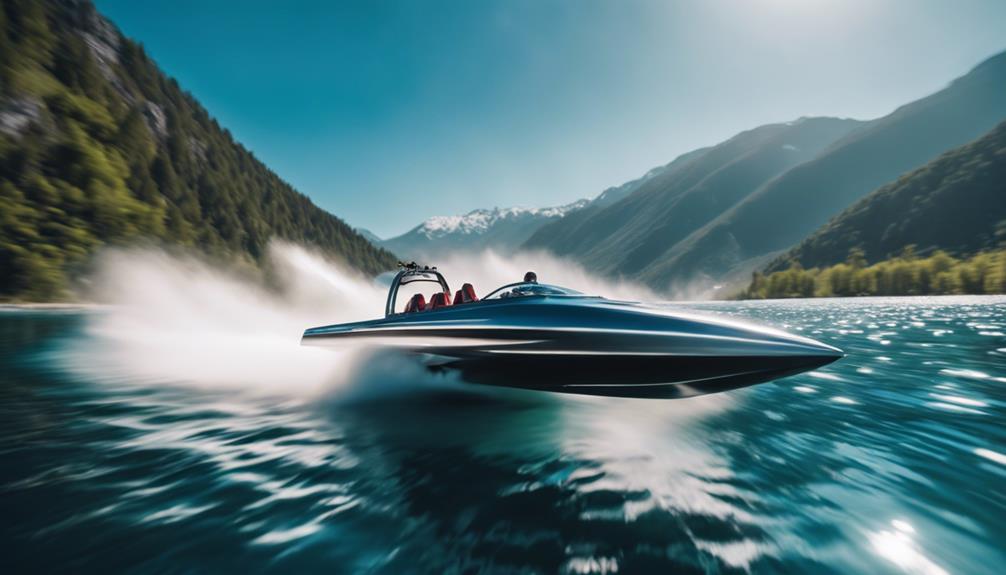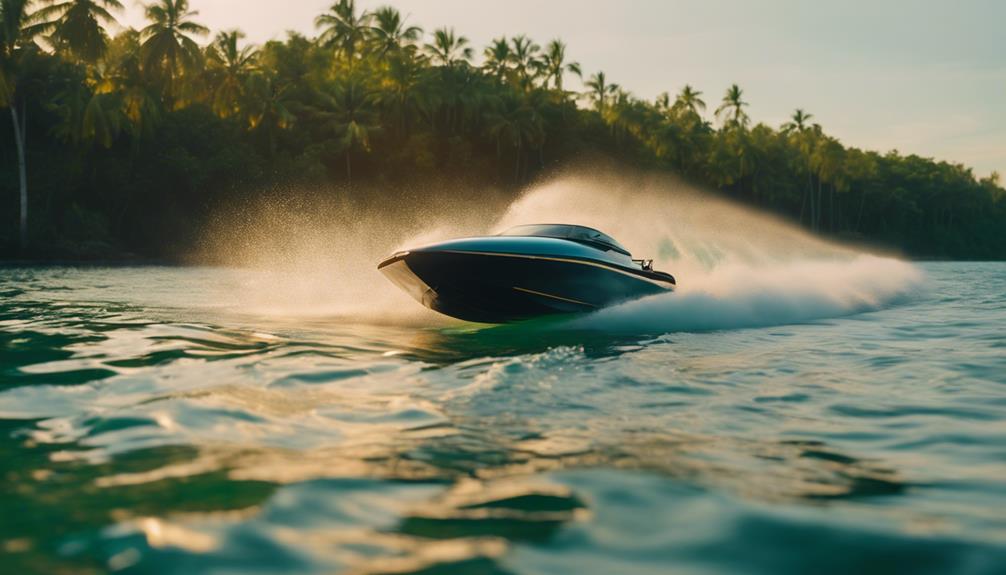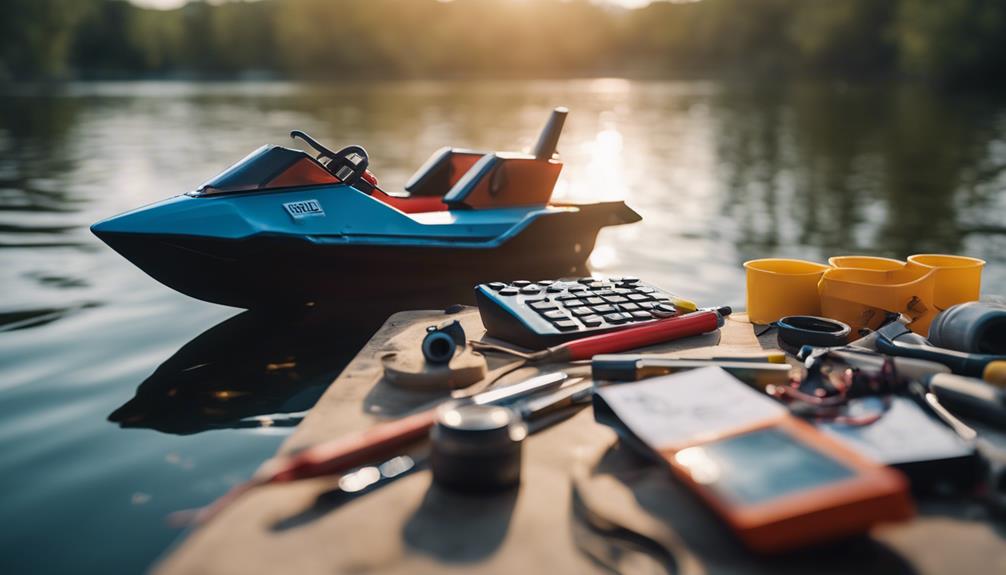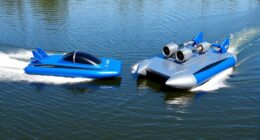Jet boats turn with incredible agility thanks to their jet propulsion system. Instead of traditional rudders, these boats manipulate water flow at the nozzle, allowing you to make sharp turns and navigate tight spaces easily. You can quickly switch directions by using reverse thrust, enhancing your control during docking or when avoiding obstacles. The no-wake setting is perfect for low-speed maneuvers, giving you precision when needed. This unique steering mechanism, combined with factors like lightweight hull design, maximizes maneuverability on the water. There's so much more to explore about jet boat handling that could elevate your boating experience.
Key Takeaways
- Jet boats utilize a jet propulsion system, allowing for sharp turns and precise control without traditional rudders.
- The manipulation of jet flow direction enhances maneuverability, enabling quick reflexes and effective pivoting in tight spaces.
- Reverse thrust capabilities contribute to rapid stopping and improved docking efficiency, especially in crowded areas.
- The no wake setting aids in low-speed operations, enhancing control during docking and maneuvering.
Jet Boat Steering Mechanism
Jet boats rely on a unique steering mechanism that directs water flow through a nozzle, giving you precise control and maneuverability. Unlike traditional boats that use rudders, jet boats utilize the jet propulsion system to achieve directional changes. This innovative approach allows you to steer with remarkable responsiveness.
When you need to make sharp turns or steer through tight spaces, you can easily adjust the jet flow for both forward and reverse thrust.
One of the standout features of jet boats is their ability to pivot in place. By reversing the thrust, you can maneuver in confined areas with agility, making docking and tight cornering a breeze. The no wake setting further enhances your steering control during low-speed operations, providing an added layer of precision when you're steering through tricky spots.
This steering mechanism not only improves maneuverability but also elevates your overall boating experience. You'll find that with just a little practice, you can confidently handle your jet boat in various conditions, making it an enjoyable and efficient way to explore the water.
Importance of Jet Flow Direction
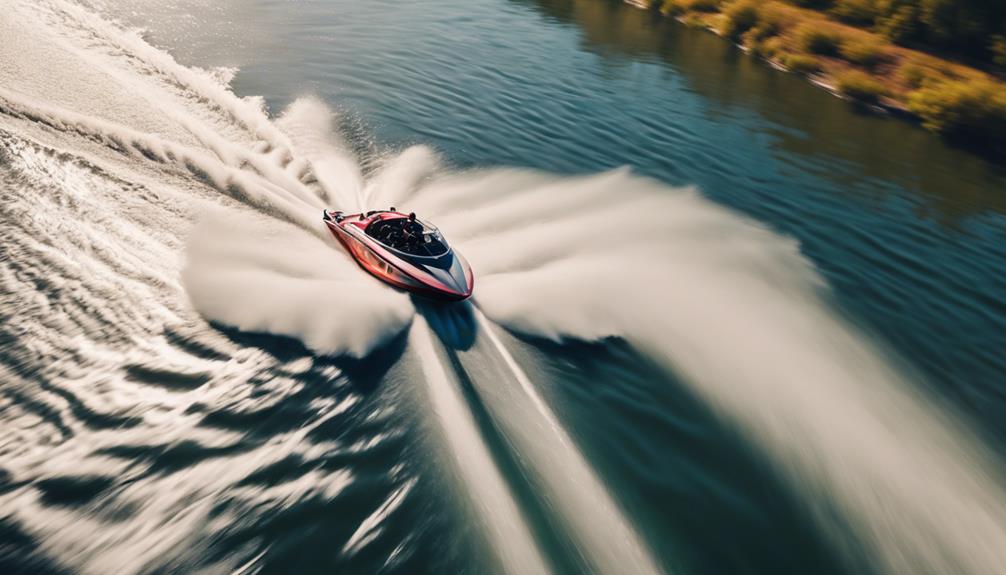
Controlling the direction of jet flow is vital for achieving ideal maneuverability and responsiveness in a jet boat. By diverting the jet flow at the nozzle, you gain precise control over the thrust direction, allowing for quick and agile maneuvers. This unique capability sets jet boats apart from traditional boats, especially in challenging conditions.
Here are a few reasons why jet flow direction is significant:
- Enhanced Steering Control: Manipulating the water jet allows for sharp turns and immediate course adjustments, giving you confidence in tight spaces.
- Reverse Thrust Capability: Adjusting the flow direction enables reverse thrust, which aids in stopping quickly and pivoting effectively during maneuvers.
- Improved Performance in Crowded Areas: The ability to control jet flow makes docking and steering through narrow passages and crowded areas far more manageable.
With this advanced steering method, you'll experience a more dynamic handling experience, particularly in choppy waters or when making quick turns.
Understanding the importance of jet flow direction will elevate your jet boating experience, making it safer and more enjoyable.
Unique Turning Capabilities

The unique steering mechanism of jet boats allows you to execute sharp turns and agile maneuvers with impressive precision. Unlike traditional boats that rely on rudders, jet boats direct water flow at the nozzle, giving you the ability to pivot and change direction almost instantly. This feature means you can steer through tight spots with remarkable ease, making jet boats perfect for docking and maneuvering in crowded waterways.
When you're on a jet boat, you'll notice how quickly you can divert water thrust in various directions. This capability is especially useful in situations where quick reflexes are necessary, such as during sudden obstacles or when avoiding other vessels. The integrated engine and hull design enhances stability and responsiveness, ensuring that you feel in control during every turn.
Whether you're skimming along a winding river or steering through busy marinas, you'll appreciate how these boats handle. Their unique turning capabilities not only make your experience more enjoyable but also enhance safety, allowing you to enjoy your time on the water with confidence.
No Wake Settings Explained

When you're docking or maneuvering tight spaces, using the no wake setting on your jet boat gives you enhanced control.
It allows you to adjust your throttle and regulate your speed effectively, ensuring smooth handling.
This feature is essential for maintaining safety and precision in congested environments.
Enhanced Control While Docking
Jet boats offer a no wake setting that greatly enhances your ability to maneuver in tight spaces and dock with ease. This feature minimizes water displacement, allowing for smoother approaches to the dock, especially in congested areas. When you engage this mode, you gain better throttle control, making slow-speed maneuvers much more manageable.
Here are three key benefits of using the no wake setting while docking:
- Reduced Wake: You can approach the dock without creating large waves that could disturb other boats or the shoreline.
- Precise Speed Management: The adjustable no wake mode allows you to fine-tune your speed, ensuring you can glide into your slip without rushing.
- Reverse Thrust Control: This setting enables you to effectively use reverse thrust, helping you to stop forward motion quickly and accurately, ensuring a smooth docking experience.
With the improved handling and stability that the no wake setting offers, you'll find docking less stressful and more enjoyable, even in tricky situations. Embrace this feature, and you'll become a pro at maneuvering your jet boat into any slip with confidence.
Throttle Adjustment Benefits
Adjusting the throttle to a no wake setting greatly enhances your control, making docking and maneuvering crowded areas much easier. This setting allows for precise throttle management, providing you with smoother handling when steering through tight spaces. By moving at a slower pace, you can avoid creating large wakes, which is particularly important in sensitive environments or near other vessels.
When you utilize the no wake setting, you're minimizing water disturbance, which not only protects the surrounding infrastructure but also prevents potential damage to your boat. This careful approach is especially crucial when approaching docks or piers, as it helps guarantee a safe and controlled entry.
Moreover, having the ability to adjust to a no wake setting boosts your confidence as an operator. You can focus on steering and positioning your jet boat without worrying about the impact of your wake. This enhanced maneuverability contributes to a safer boating experience, allowing you to steer through crowded areas with ease.
Optimal Speed Regulation
Utilizing the no wake setting on your boat provides excellent speed regulation, allowing for precise control while steering through narrow or crowded areas. This feature is particularly vital when you're docking or maneuvering near other vessels.
Here are three key benefits of engaging the no wake setting:
- Enhanced Precision: With reduced throttle control, you can navigate tight spaces smoothly and accurately, ensuring you avoid potential obstacles.
- Safety and Compliance: Maintaining a slow, steady pace not only keeps your boat under control, but it also helps you comply with local regulations that limit wake size in certain areas. This promotes responsible boating practices.
- Minimal Environmental Impact: By minimizing the wake you create, you're protecting surrounding marine environments, making your boating experience more eco-friendly.
When you engage the no wake setting, you can easily glide through marinas or along shorelines, ensuring a safe and enjoyable outing. This feature truly enhances your overall maneuverability, allowing you to focus on the experience without worrying about creating disturbances in the water.
Docking Maneuvers and Techniques
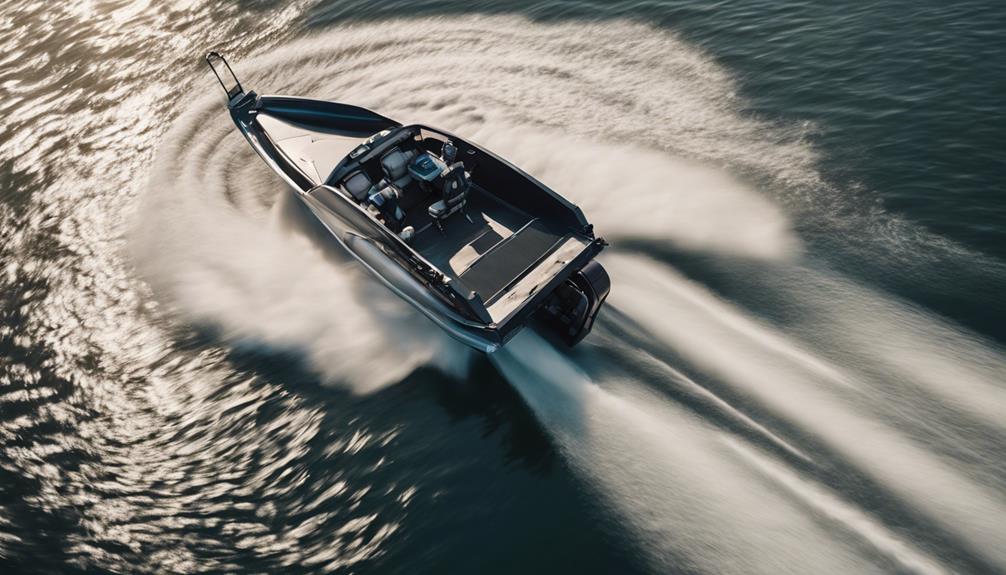
When you're ready to dock your jet boat, approach the dock at a hard angle to pivot effectively.
Using reverse thrust helps you stop just before you reach the dock, making the process smoother.
Once you're aligned and the engine's off, securing the lines right away is essential to prevent any drifting.
Approaching the Dock
Approaching the dock at a hard angle helps you maintain control and align the boat more effectively with the pier. As you near the dock, remember these key techniques for a successful entry:
- Utilize Reverse Thrust: Just before contact, engage reverse thrust to halt your forward motion. This gives you precise control over your speed and allows you to adjust as needed.
- Pivot Towards the Dock: Turn the wheel appropriately during your final approach. This helps the boat pivot in the right direction, ensuring a smooth entry and alignment with the dock.
- Aim for the Front Half of the Slip: If you're docking between boats, steer towards the front half of the slip. This strategic positioning provides you with extra space to maneuver, reducing the chances of collision.
Once you've aligned the boat properly at the dock, cutting the engines will complete the process smoothly and securely.
Securing the Boat
Securing the boat involves a series of precise docking maneuvers that guarantee your vessel stays in place and is ready for disembarkation. When you approach the pier, come in at a hard angle and use reverse thrust to halt your forward motion just before you touch the dock. If you need to pivot toward the dock, turn the steering wheel opposite to the side you're docking on while applying reverse thrust simultaneously.
If you're docking between boats, aim for the front half of the slip; this gives you enough space to maneuver and align properly. For bow-in docking, raise the bolster seat for better visibility and use throttle feathering to control your speed.
Once you've successfully aligned the boat with the dock, cut the engines and secure the lines. Here's a quick reference table to keep in mind:
| Maneuver Type | Key Action | Purpose |
|---|---|---|
| Hard Angle Approach | Use reverse thrust | Stop forward motion |
| Pivoting | Turn opposite direction | Align with the dock |
| Bow-In Docking | Raise bolster seat | Enhance visibility |
With these techniques, you'll dock like a pro!
Factors Affecting Maneuverability

Maneuverability in jet boats hinges on several key factors, including their unique steering mechanism and lightweight construction, which together enable quick and precise turns. Understanding these elements can enhance your experience on the water and improve your handling skills.
Here are three important factors that affect maneuverability:
- Steering Mechanism: Jet boats use a steering system that diverts jet flow at the nozzle, allowing you to control your direction more effectively. This feature makes it easier to execute sharp turns.
- Hull and Engine Design: The integration of the hull and engine boosts performance in various water conditions. A well-designed hull contributes to stability, which is essential when steering through tight spots.
- Reverse Thrust Capabilities: Utilizing reverse thrust can help you stop quickly and pivot your boat. This ability is vital for making immediate directional changes, especially in crowded areas.
Best Practices for Sharp Turns

To execute sharp turns effectively in a jet boat, you need to combine precise steering with the strategic use of reverse thrust to maintain control and balance. Start by turning the steering wheel hard in the direction you want to go. As you do this, engage reverse thrust to counteract your forward momentum. This technique allows for rapid changes in direction without relying on traditional rudders.
Utilizing the no wake setting during these maneuvers can further enhance your control and throttle management. Practicing sharp turns in open water before entering crowded or confined areas will help you familiarize yourself with your boat's handling characteristics.
Here's a quick reference table to guide your practices:
| Best Practices | Description |
|---|---|
| Precise Steering | Turn the wheel sharply in the desired direction. |
| Reverse Thrust | Apply reverse thrust to counter forward momentum. |
| No Wake Setting | Use this setting for enhanced control during turns. |
Frequently Asked Questions
How Does Jet Boat Steering Work?
Jet boat steering works by directing water through the jet nozzle. You manipulate the steering wheel to adjust the nozzle's angle, allowing for quick turns and effective reverse thrust, enhancing your control in tight spaces.
Are Jet Boats Hard to Maneuver?
Jet boats aren't hard to maneuver once you get the hang of it. With practice, you'll find their responsive steering and low-speed control make tight turns and docking easier, even in challenging conditions.
How to Maneuver a Jet Boat?
Maneuvering a jet boat's easier than you think! Approach your destination at an angle, use reverse thrust to slow down, and practice feathering the throttle while steering for precise control in tight spaces.
How Are Jet Boats Propelled?
Jet boats are propelled by water jet propulsion systems that draw water in and expel it through a nozzle. This design provides immediate throttle response, allowing you to navigate tight spaces and shallow waters efficiently.
What Technology Allows Jet Boats to Maneuver and Go in Reverse?
Jet boats utilize specially designed water jet propulsion systems to achieve reverse motion. This unique technology allows jet boats to maneuver in tight spaces and navigate in reverse with ease. Instead of using traditional propellers, how jet boats reverse technology utilizes water jets to create powerful thrust in any direction.
Conclusion
In summary, mastering jet boat maneuverability is like learning to dance on water.
By understanding the steering mechanism and jet flow direction, you can glide effortlessly through tight turns and navigate tricky docking situations.
Remember to take into account factors like speed and water conditions, and practice sharp turns with confidence.
With a bit of finesse, you'll be twirling your jet boat through the waves, leaving a trail of excitement behind you.
Enjoy every splash!


